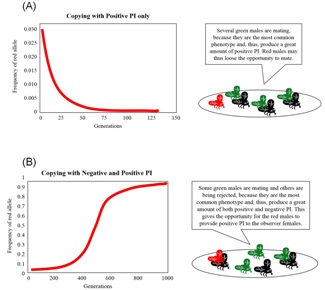Biology

Negative Information in Mate-Choice Copying
Choosing whom to mate with is one of the most important decisions for any living organism, especially for females, for whom the costs of reproduction are generally higher. It is, therefore, expected that sexual selection will act on female mate choice behaviour, favouring the ones capable of making the better decisions. The classical models of female mate choice evolution assume that their preferences are genetically innate. This means that females with an (e.g.) allele for “green preference” would prefer mating with males displaying green ornaments, and that this preference will never change throughout females’ lives, independently of the performance of green males. Are females’ preference exclusively genetic and, therefore, immutable? Empirical evidence suggests it is not.
References
Santos, M.; Matos, M.; Varela, S.A.M. Negative public information in mate-choice copying helps the spread of a novel trait. American Naturalist. 2014, vol. 184, num. 5, p. 658-672. doi: 10.1086/678082.
Recent work indicates that females’ mate preferences might change in the course of their lives through social learning. In several vertebrate species – e.g. guppies, Japanese quails, mice, humans – and, amazingly enough, in one small-brained invertebrate species – Drosophila melanogaster –, females copy each other mate choice decisions. This behaviour is known as mate-choice copying and occurs when an observer female, generally young and inexperienced, witnesses the mating decision of a model female, generally older and more experienced. If the model female accepts to mate with a (e.g.) red male, and if the observer female, with a genetic preference for green, subsequently decides to mate with red males, we would say that there has been mate-choice copying. Hence, mate-choice copying is said to occur when there is a behavioural change in the mating decisions of a female after acquiring social information provided by other females. In our example, copying has occurred because the genetic preference for green was replaced by the learned preference for red.
What are the evolutionary implications of mate choice copying? This important question has been tackled several times in the literature, and the answer is that female mate copying behaviour is generally maladaptive: a new gene conferring the males a higher fitness may not spread in the population because most females will mate with the unfit, common male and the inexperienced females will copy this behaviour. This generates a frequency-dependent bias, or the pressure to conform to the majority view; something that social psychologists know to be a barrier for the spreading of novel cultural traits.
Our study provides a new understanding of the role of mate-choice copying in sexual selection, because it explores two types of public information. There are indeed two ways of learning from other female mating decisions: when experienced females accept to mate (e.g.) with a red male, they will be producing positive public information about those males to the observer females, who may become more prone to mate with red males. On the other hand, when the same experienced females reject to mate with a red male because these females can be unreceptive to further copulations, they would produce negative public information that naive females can copy. Previous mathematical models had only considered positive public information, leading to the frequency-dependent bias and avoiding a fitter gene to spread. Incorporating both types of social information results in a qualitative change because positive and negative public information cancelled each other out, thus increasing the likelihood that a fitter gene can eventually spread in the population.
Mate-choice copying thus seems to effectively affect the course of sexual selection. In our model the transmission of non-genetic information among females affects the genetic evolution of male traits, as predicted by the mate-choice copying hypothesis. Our results are, however, dependent upon other factors, such as a species mating system (female receptivity), which highlights the complexity of the mate-choice copying behaviour in an evolutionary context and opens new questions for further studies.
Top left figure. Evolutionary fate of a fitter red allele introduced at a low frequency at the initial generation. (A) The red allele will not spread in the population because mate-choice copying biases the mating preferences towards the common green males. In other words, naive females will mostly observe matings with the common green males, and their learned mating preferences will rely exclusively in the positive public information (PI) provided by copulating females. (B) If naive females also ponder the failures of the common males when trying to copulate unreceptive females, the fitter allele can spread to fixation.
Susana A. M. Varela
Margarida Matos
Universidade de Lisboa
Mauro Santos
Department of Genetics and Microbiology
2024 Universitat Autònoma de Barcelona
B.11870-2012 ISSN: 2014-6388
